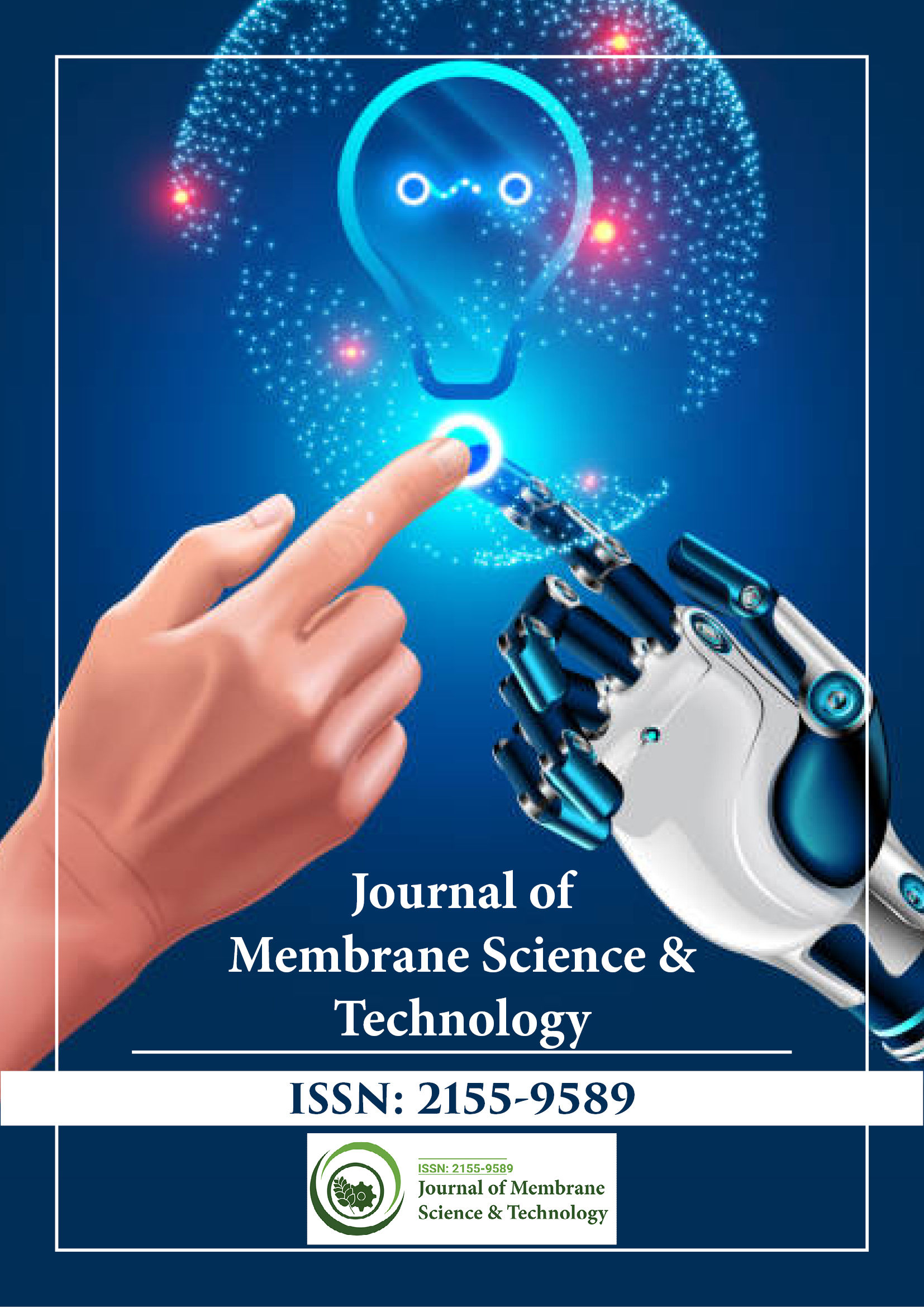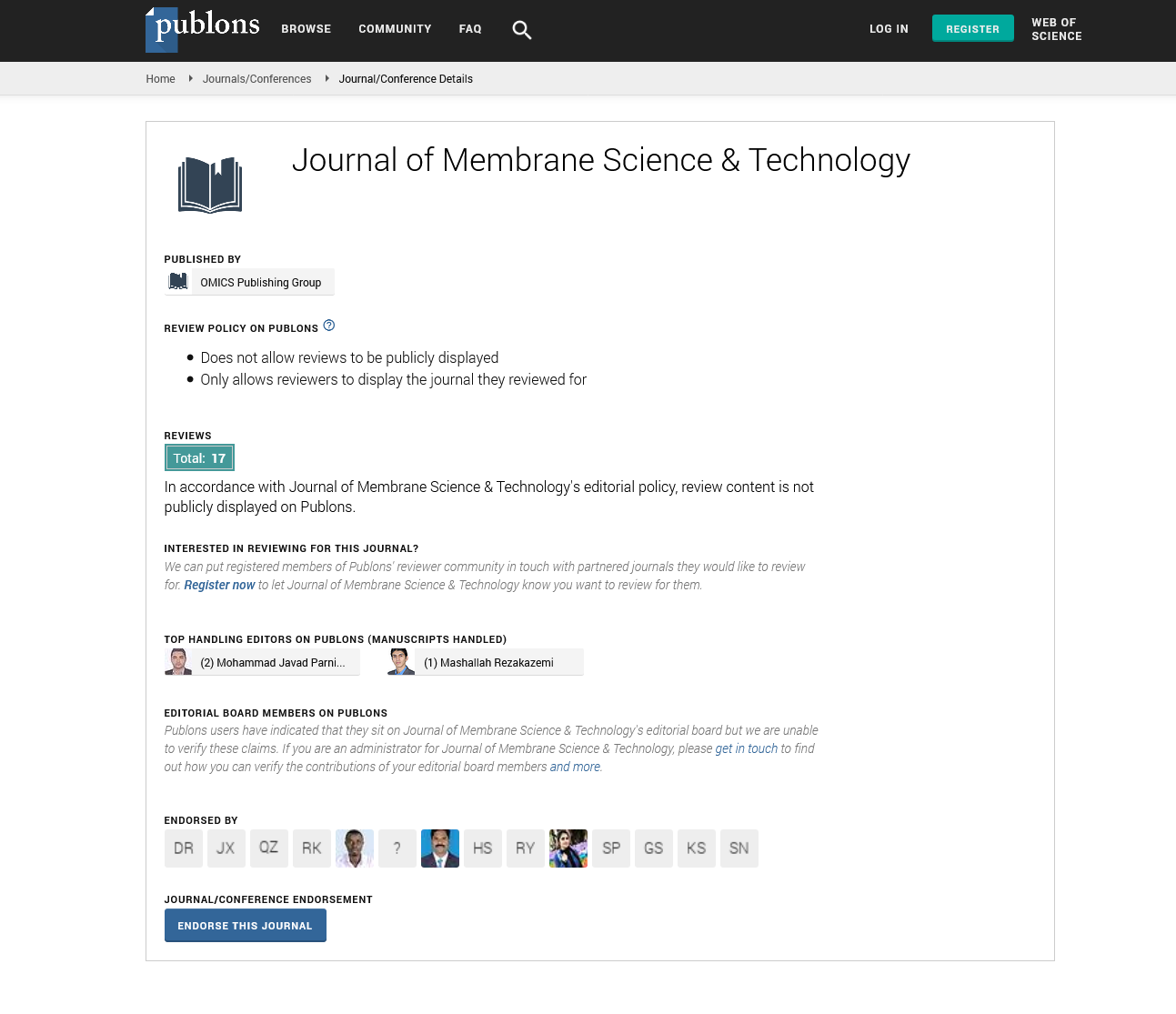Indexed In
- Open J Gate
- Genamics JournalSeek
- Ulrich's Periodicals Directory
- RefSeek
- Directory of Research Journal Indexing (DRJI)
- Hamdard University
- EBSCO A-Z
- OCLC- WorldCat
- Proquest Summons
- Scholarsteer
- Publons
- Geneva Foundation for Medical Education and Research
- Euro Pub
- Google Scholar
Useful Links
Share This Page
Journal Flyer

Open Access Journals
- Agri and Aquaculture
- Biochemistry
- Bioinformatics & Systems Biology
- Business & Management
- Chemistry
- Clinical Sciences
- Engineering
- Food & Nutrition
- General Science
- Genetics & Molecular Biology
- Immunology & Microbiology
- Medical Sciences
- Neuroscience & Psychology
- Nursing & Health Care
- Pharmaceutical Sciences
Perspective - (2024) Volume 14, Issue 4
Membranes Enhanced with Graphene Oxide for Efficient Absorption on Targeted Ion
Rajiv Desai*Received: 29-Nov-2024, Manuscript No. JMST-24-27300; Editor assigned: 02-Dec-2024, Pre QC No. JMST-24-27300 (PQ); Reviewed: 16-Dec-2024, QC No. JMST-24-27300; Revised: 23-Dec-2024, Manuscript No. JMST-24-27300 (R); Published: 30-Dec-2024, DOI: 10.35248/2155-9589.24.14.405
Description
Selective ion separation is essential across a variety of industries, including water purification, energy storage and environmental remediation. Among the emerging technologies, Graphene Oxide (GO) functionalized membranes have shown remarkable and significant due to their unique structure and properties. GO, a derivative of graphene, has oxygenated functional groups on its surface, which can be used to control ion transport and enhance selectivity. This article examines the development and applications of GO functionalized membranes in ion separation, highlighting their advantages, challenges and perspective research directions.
Graphene oxide: A new material for membrane technology
Graphene oxide is a two-dimensional material derived from graphite through oxidation processes. Unlike pure graphene, GO contains oxygenated groups such as hydroxyl, epoxy and carboxyl groups, which make it hydrophilic and suitable for interactions with a range of ions. These functional groups allow GO sheets to interact with water molecules and ions selectively, creating opportunities for controlled ion transport. GO also offers exceptional mechanical strength and flexibility, making it a promising candidate for various membrane applications.
Mechanisms of ion selectivity in GO membranes
GO membranes utilize several mechanisms to achieve selective ion separation:
Size exclusion and nanoconfinement: The spacing between GO layers, known as interlayer distance, can be controlled to create nanochannels. These channels allow small ions to pass through while blocking larger ones, providing a size-exclusion mechanism that enhances selectivity. For example, sodium ions can be allowed to pass through a GO membrane, while larger ions like calcium may be restricted.
Charge-based selectivity: The oxygenated groups on GO surfaces carry partial charges, which interact with ions based on their charge and hydration energy. This allows GO membranes to preferentially transport certain ions over others based on their charge, making it possible to separate cations from anions or differentiate ions with varying valencies.
Applications in ion separation
GO functionalized membranes have been applied in several major areas requiring high-performance ion separation:
Water desalination: In desalination, removing salt ions from seawater is significant for producing freshwater. GO membranes are particularly effective in selective salt ion separation due to their tunable interlayer spacing and charge-based selectivity. Studies have demonstrated that GO membranes can achieve high salt rejection while maintaining fast water transport rates, making them suitable for low-energy desalination processes.
Energy storage systems: In energy storage, such as in lithium-ion and sodium-ion batteries, efficient ion transport is essential for high energy density and power output. GO membranes facilitate selective ion movement, enhancing battery performance by allowing the transport of desired ions (like lithium or sodium) while blocking unwanted ones. This selective ion transport has significant to increase the efficiency and lifespan of batteries, making GO membranes valuable for advanced energy storage solutions.
Challenges in GO enhanced membrane development
Despite the advantages, GO functionalized membranes face several challenges that must be addressed for practical applications:
Membrane stability and durability: GO membranes are sensitive to changes in environmental conditions, such as pH and temperature, which can impact their stability. Prolonged exposure to high-salinity or acidic conditions can degrade GO layers, reducing membrane effectiveness over time. Researchers are investigating leads to improve GO stability through cross- linking or by embedding GO in protective polymer matrices.
Conclusion
Graphene oxide functionalized membranes represent a breakthrough in ion separation technology, combining high selectivity, permeability and tunability. Their unique structural and chemical properties allow them to address challenges in water desalination, energy storage and pollution control. While challenges remain in stability, scalability and fouling resistance, ongoing research is more robust and versatile GO membranes. As innovations continue, GO functionalized membranes have the importance to revolutionize ion separation processes, offering sustainable solutions for a range of industrial and environmental applications.
Citation: Desai R (2024). Membranes Enhanced with Graphene Oxide for Efficient Absorption on Targeted Ion. J Membr Sci Technol. 14:405.
Copyright: © 2024 Desai R. This is an open-access article distributed under the terms of the Creative Commons Attribution License, which permits unrestricted use, distribution, and reproduction in any medium, provided the original author and source are credited.

